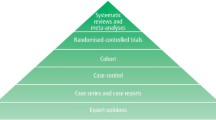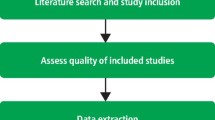Abstract
Data sources
Electronic (PubMed and Medline) and hand searching of three dental public health journals, Community Dental Health, Community Dentistry and Oral Epidemiology and the Journal of Public Health Dentistry 1993 - 2008.
Study selection
Studies defined as controlled experiments using a random method to assign study units were included: papers reporting secondary analysis, pilot studies and those that provided brief methodological descriptions were excluded.
Data extraction and synthesis
Each article included in the study was assessed and scored independently by two observers, with any discrepancies being resolved by discussion Articles were assessed using the CONSORT criteria.
Results
119 RCTs were initially identified (85 electronically and 33 from hand searching) and of these 48 were assessed. Of the 56 CONSORT criteria there were on average 27 (SD 6.9) present. The average number of criteria increased over the period.
Conclusions
There were inadequacies in the reporting of trials in dental public health journals. The quality of the reporting could be improved if the CONSORT statement were followed more closely.
Similar content being viewed by others
Commentary
This study is similar to others that have looked at the quality of RCTs reported in the dental disciplines assessed using the CONSORT criteria.1, 2, 3 It has identified similar findings noted within the other dental disciplines, namely that we could do better at reporting the RCTs we undertake in dentistry.
This study has a much narrower focus in comparison the others noted above, looking as it does at only three core dental public health journals. As a consequence it will not have included all the RCTs that could have been included within the remit of dental public health. But along with the other papers noted above1, 2, 3 it does contribute to the available information about the quality of reporting of dental research. The guidance for authors for each of the three journals searched now recommends the use of CONSORT for reporting RCTs. However, of these only Community Dentistry and Oral Epidemiology is formally listed on the CONSORT website (www.consort-statement.org) as an endorsing journal. While reporting studies in line with the CONSORT statement is a laudable aim and will improve the overall quality of research it is important to bear in mind that it is still necessary to establish whether the results of the studies should be believed, and this can be undertaken by establishing the risk of bias.4 Fortunately, well established appraisal tools such as those developed by CASP (Critical Skills Appraisal Programme) are available (www.sph.nhs.uk/what-we-do/public-health-workforce/resources/critical-appraisals-skills-proramme) to help the RCT reader decide.
What is disappointing though is that 56% of the RCTs in this sample did not include any details of the randomisation, with 62.5% not reporting on whether the outcome assessors were masked. While the authors report some indication that there are signs of improvement in more recent years, there is still clearly much to be done to improve the quality of research reporting.
References
Flint HE, Harrison JE . How well do reports of clinical trials in the orthodontic literature comply with the CONSORT statement?. J Orthod 2010; 37:250–261. PubMed PMID: 21186305.
Pandis N, Polychronopoulou A, Eliades T . An assessment of quality characteristics of randomised control trials published in dental journals. J Dent 2010; 38:713–721. Epub 2010 Jun 9. PubMed PMID: 20546823.
Al-Namankany AA, Ashley P, Moles DR, Parekh S . Assessment of the quality of reporting of randomized clinical trials in paediatric dentistry journals. Int J Paediatr Dent 2009; 19: 318–324. Epub 2009 Mar 23. PubMed PMID: 19320912.
Higgins JPT, Green S (eds). Assessing the risk of bias in included studies. In Cochrane Handbook for Systematic Reviews of Interventions Version 5.1.0 [updated March 2011]. Chapter 8. The Cochrane Collaboration 2011. Available from www.cochrane-handbook.org.
Author information
Authors and Affiliations
Additional information
Address for correspondence: Dr Zoe Marshman, Department of Oral Health and Development, School of Clinical Dentistry, Claremont Crescent, Sheffield, UK. E-mail: Z.Marshman@sheffield.ac.uk
Marshman Z, Farid F. The quality of reporting of randomised controlled trials in dental public health. Community Dent Health 2010; 27: 253–256.
Rights and permissions
About this article
Cite this article
Richards, D. Quality of reporting randomised controlled trials in dental public health. Evid Based Dent 12, 54 (2011). https://doi.org/10.1038/sj.ebd.6400797
Published:
Issue Date:
DOI: https://doi.org/10.1038/sj.ebd.6400797



